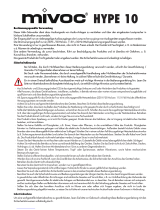
00052709.DOC, Version 1.0
2/41
Inhaltsverzeichnis / Table of contents
EINFÜHRUNG................................................................................................................................................... 3
SICHERHEITSHINWEISE................................................................................................................................. 3
BESTIMMUNGSGEMÄßE VERWENDUNG..................................................................................................... 5
RECHTLICHE HINWEISE................................................................................................................................. 7
K
leine Hörkunde............................................................................................................................................. 7
GERÄTEBESCHREIBUNG............................................................................................................................... 8
Features ......................................................................................................................................................... 8
Auspacken & Transport.................................................................................................................................. 8
Geräteübersicht.............................................................................................................................................. 9
INBETRIEBNAHME .......................................................................................................................................... 9
Eingänge ...................................................................................................................................................... 10
Ausgänge ..................................................................................................................................................... 11
Speaker Out ................................................................................................................................................. 12
INSTALLATION .............................................................................................................................................. 13
Stacking........................................................................................................................................................ 13
Satellitensysteme ......................................................................................................................................... 13
Montage auf einem Stativ bzw. Boxenhochständer..................................................................................... 14
Überkopfmontage......................................................................................................................................... 15
Montage auf einer Wandhalterung............................................................................................................... 17
Fliegende Installation ................................................................................................................................... 18
Anschluss ans Netz...................................................................................................................................... 20
REINIGUNG UND WARTUNG........................................................................................................................ 20
Sicherungswechsel ...................................................................................................................................... 21
TECHNISCHE DATEN .................................................................................................................................... 22
INTRODUCTION ............................................................................................................................................. 23
SAFETY INSTRUCTIONS............................................................................................................................... 23
OPERATING DETERMINATIONS.................................................................................................................. 25
Legal instructions ......................................................................................................................................... 26
Information on hearing loss.......................................................................................................................... 27
DESCRIPTION OF THE DEVICE ................................................................................................................... 28
Features ....................................................................................................................................................... 28
Unpacking & transportation.......................................................................................................................... 28
Overview ...................................................................................................................................................... 29
START-UP....................................................................................................................................................... 29
Inputs............................................................................................................................................................ 30
Outputs......................................................................................................................................................... 31
INSTALLATION .............................................................................................................................................. 32
Stacking........................................................................................................................................................ 32
Satellite-systems .......................................................................................................................................... 33
Installation on a stand or speaker stand ...................................................................................................... 33
Overhead installation ................................................................................................................................... 34
Installation on a wall-mounting..................................................................................................................... 37
Suspended installation ................................................................................................................................. 38
Connection with the mains........................................................................................................................... 39
CLEANING AND MAINTENANCE ................................................................................................................. 39
Replacing the fuse ....................................................................................................................................... 40
TECHNICAL SPECIFICATIONS..................................................................................................................... 41
Diese Bedienungsanleitung gilt für die Artikelnummer 11038822
This user manual is valid for the article number 11038822
Das neueste Update dieser Bedienungsanleitung finden Sie im Internet unter:
You can find the latest update of this user manual in the Internet under:
www.omnitronic.com






















